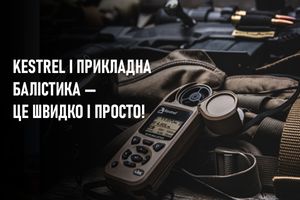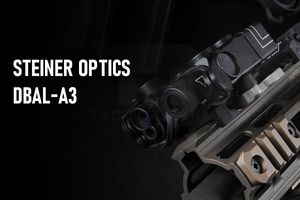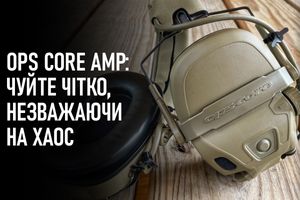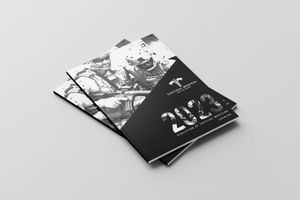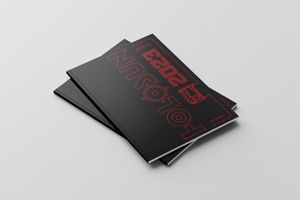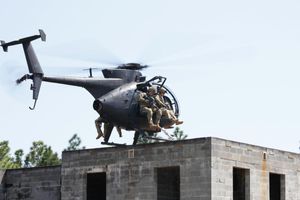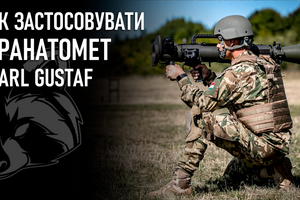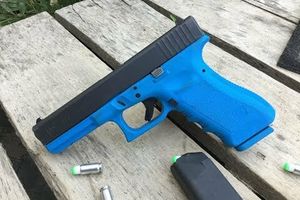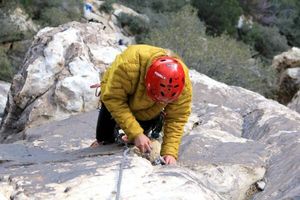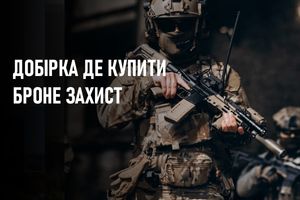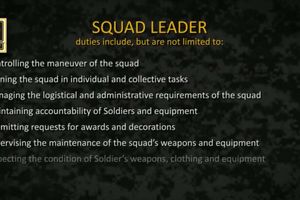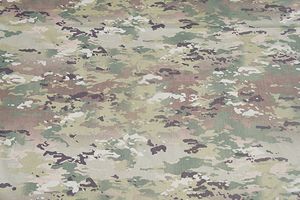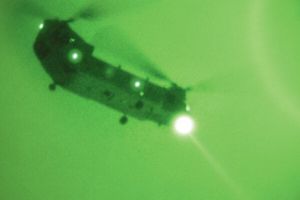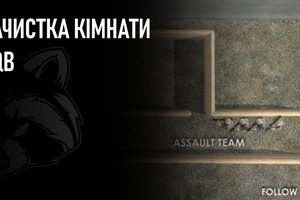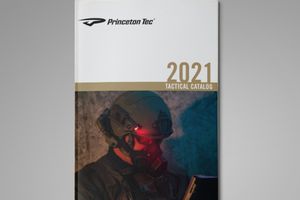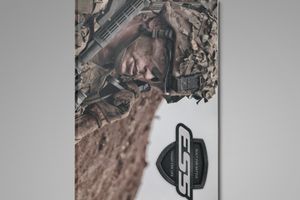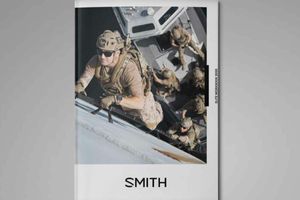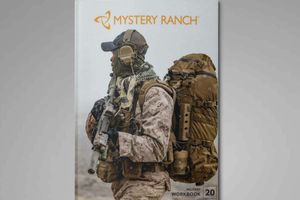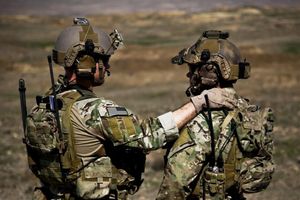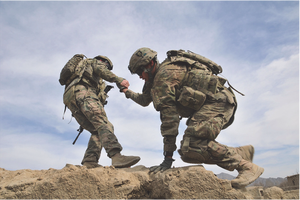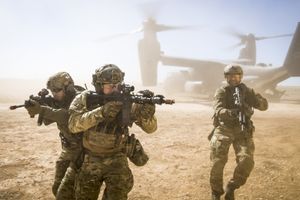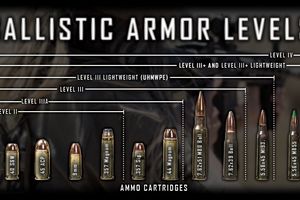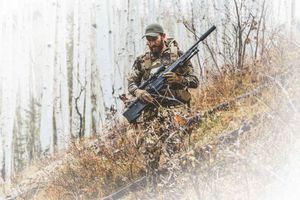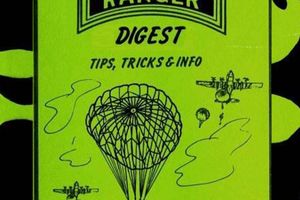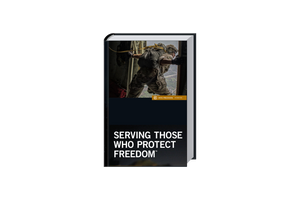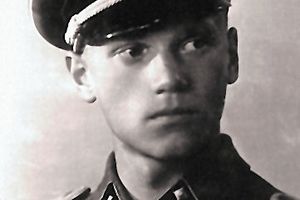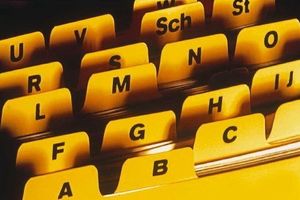Previous Chapter 1: "The Right to Wear a T-shirt. Purpose"
"How to swim 50 meters under water and not die"
Self confidence.
While chunks of ice floated outside the window in the sea, I zipped up my wetsuit.
This morning we found a bloody corpse of a seal on the shore. His side was ripped open, and the sand around his carcass was covered in blood. Most likely it was a killer whale. In a little less than an hour, my comrades and I were supposed to go under water and plant a mine on board the US Navy ship.
I was a little comforted by the fact that the killer whale had had a snack not so long ago and had a full stomach.
I was the new SEAL who had completed the BUD/S qualifying course nine months earlier and it was a pleasure to be back in Alaska, despite the fact that it was an exercise. The teachings legend was as easy as shelling pears. My platoon of SEALs played the role (OPFOR - opposing force) of the alleged enemy, in other words, we were the bad guys. Our task was to organize an attack on an assault ship moored at the pier of the city of Ketchikan, Alaska. We had to get close enough to the ship to mine it. The ship's crew consisted of a small detachment of soldiers who were engaged in security and surveillance. Their main task was to counter threats like us.
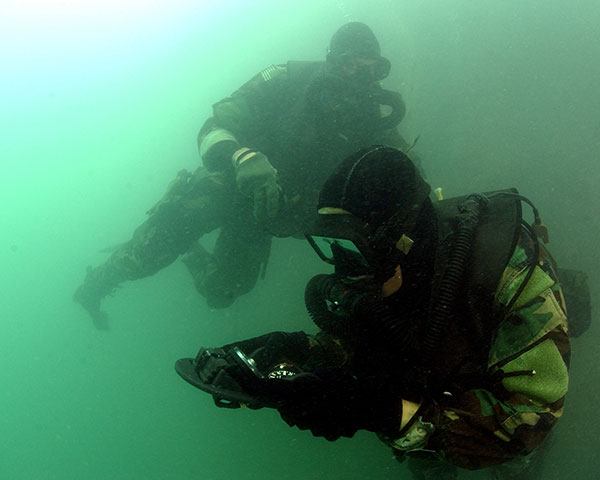
During our preparation for the assignment, the pier was covered with snow, and the water was on the verge of freezing. I put black camouflage makeup on my face and put on thermal underwear under the wetsuit.
One of my comrades knocked on the door, I took all the necessary equipment and we moved out. In the parking lot, we met four more of ours, also dressed in wetsuits and with smeared faces, together we plunged into a waiting van.
Our entire team consisted of newcomers.
If the dark cold waters and killer whales did not frighten us much, then most of all we worried about "Flipper", a killer dolphin who was waiting for us somewhere in the depths ...
I am not kidding.
The fleet had combat dolphins at their disposal, which were trained to attack swimmers. Dolphins were part of the U.S. Navy's naval combat mammal program. (U.S. NAVY Marine Mammal Program) which trained dolphins and fur seals to detect mines, protect ports and ships. In addition to the United States, Russia also had combat dolphins; huge funds were spent on the development of this program. Dolphins were used during the Gulf War and in operations off the coast of Iraq. The Russians scrapped the program in the 90s and, according to official figures, sold their dolphins to Iran.
The Navy brought three dolphins to Alaska from San Diego. One dolphin was in cages at each end of the ship, while the third was in the water. The dolphins on the ship were trained to use their sonars to spot swimmers. It was assumed that if they found him, they would pull on the ring tied to the bell in their cage. The personnel located next to the cages, in turn, had to report on the radio that the dolphin was hearing something, and then patrol boats would go looking for us.
A dolphin located directly in the water noticing a swimmer - attacks him until he floats to the surface. We guessed that this whopper could reach us. The very dubious fun of entering the icy black water at night, with the likelihood that a dolphin walking at full speed could fly into you, this added some alarm to our mission ...
A couple of hours before we got into the water, two of my colleagues, dressed in civilian clothes, were walking in the docks nearby and they had two oxygen tanks with them.
Approaching the congestion of ships, they imperceptibly threw the cylinders into the water, having previously unscrewed the valve so that the vented air created bubbles in the water. Before leaving, my friends fixed the cylinders to the pier beam so that they would not be carried away. Air bubbles created noise under the water - thereby masking our approach to the target.
Leaving the hotel parking lot, we went to the river that flows through the city and flows into the sea. On the bumpy roads of Ketchikan, our van was pretty shaken. I heard our equipment clattering behind the partition. All were silent. I was nervous. I was not the best swimmer, and I had problems with orienteering in pitch darkness under water, and then there was this killer dolphin ... in general, it was not easy. But something else scared me more ...
Most of the city was built on wooden docks. Normally, we would have to swim in the sea along the main channel, but there you can definitely meet a dolphin. We decided to make our way through an extensive network of docks. If we enter the sea from the side of the river, then huge supports will hide our movements. But at the same time it meant swimming among the heap of these supports and debris in full crown. For obvious reasons, we could not use our flashlights. We will have to slowly move from support to support. And all this is almost to the touch.
The van stopped and we heard the driver, a guy from our unit, talking to the guard. My heart was ready to jump out and I heard all my comrades breathing. If the guards inspect the truck, everything is lost. Seconds passed, very long seconds. Finally, I heard the engine growl and we drove into the bay area.
Finally the car slowed down and stopped. The driver turned off the engine and a second later opened the tailgate. I and three other swimmers climbed out of the trunk and headed for the water ...
We split into pairs and went into the water at the same time, so as not to lose sight of each other. I did not move more than one and a half meters away from my partner. We were already up to our throats in the water. I took two deep breaths, took the regulator in my mouth, my partners and I showed each other thumbs up and began to plunge deeper into the icy water. As soon as the water swept over my face and head, I caught my breath. A second later, we were in pitch darkness.
Then I just thought: "I hate swimming underwater."
I was nervous. It was one of my first assignments, albeit a training one, but the dangers that awaited us under water were quite real. I was aware that service in SEAL meant underwater operations, but to be honest I was afraid to say them. Water tests during BUD / S were difficult for me. Crosses, push-ups during the qualifying course did not bother me at all, but the water was scary! I didn't surf. And swimming too. I haven't really swam since my childhood when I lived in Alaska.
I remember once in my childhood I, on a bet with my father, tried to swim across the river that flowed next to our house. I had to swim against the current and it slowed me down a lot. In the end, when I got to the opposite bank, I was blown away by the current for a quarter of a mile. This swim was the longest in my life before I got on BUD / S. When the time came for the test to swim 50 meters under water, I experienced the same anxious feelings as now when we are preparing to swim under the piers of Alaska ...
The 50m underwater swim is one of the first elimination trials on the BUD / S. I remember that it was a sunny June day, there were no clouds in the sky, only blue sky. The pool was located at the Coronado naval base near San Diego Bay.
Me and the guys in my kit ran around this pool. We have already managed to spend several hours in the cold water of the surf and run along the shore. Everyone knew that the above test in the pool was about to take place and got nervous. We lined up at the edge of the pool and listened to the safety briefing.
"If you do not want to fly out, then you have to pass this test, the most important thing is to stay calm."
There was no time limit. The task is to swim 50 meters under water to one end of the pool and back in one breath. The instructors insured us while in the water and were ready to help if something went wrong. A team of doctors was also on duty not far from the pool.
As always, everything was simple only in words. The instructors immediately cut all the possible benefits. It was impossible to push off the walls of the pool. We had to jump into the water with our feet together - hands at the seams and only then begin the swim.
The diving was part of the first leg of BUD / S, which also included a grueling five and a half days called "Hell Week". During this week, each cadet sleeps about four hours a day, the rest of the time was occupied by crosses and other training.
The main goal of the qualifying course is to make your mind and body understand that you can always do much more than you think. This is the very first test on the way of the "fur seal". SEAL's motto “The easiest day was yesterday” became then more than clear to us.
BUD / S consists of several main blocks. The very first - a 50-meter swim under water and "Hell's Week", then there is training in diving and in the final - shooting and explosive training. First, you take baby steps and in the end you work with things that can kill you if you make a mistake somewhere. You need to go through each stage. Fall on one and get kicked out.
I knew swimming was my weak point. In college, my SEAL buddy taught me to swim with brace and sideways. And for another semester, I trained with the college team. Regardless of the above, this BUD / S test worried me the most. All or nothing. I realized - no matter how tired, nervous or scared I was, I shouldn't have given the slightest doubt a chance to creep into my head. I will do it.
The safety briefing was over. There were splashes of water, the guys began to jump into the water. The night before the test was full of advice and debate about how best to pass this test. The main question is how to stay at depth? I didn't want to be just a foot underwater, as I could accidentally raise my head and so I decided to try to stay six to seven feet deep.
I sat in silence and waited for my name to be called. A few minutes later, I walked to the edge of the pool, took two deep breaths, and tried to relax and focus on the task.
It's simple, I told myself. “All the instructors did it. That's quite possible. Relax".
When it was my turn, I jumped into the pool and disappeared under the water. I pressed my head to my chest and straightened my legs. I felt the water trying to get into my nostrils and make me breathe out some air. The beginning was difficult ...
Starting to work with my hands, I swam to the far end of the pool. It seemed that there was more than 25 meters. I knew my goal was to conquer the distance, and not meet a certain time, so I was in no hurry. I concentrated on long and confident strokes.
I was feeling fine, but I could not stop thinking about how far the wall to which I was swimming seemed to be. At the bottom, I saw one of the safety instructors. He was with oxygen equipment and was watching us, ready to come to the rescue at any second.
Another instructor was nearby. In his diving mask and snorkel in his mouth, he reminded me of some kind of predator ready to rush at his prey.
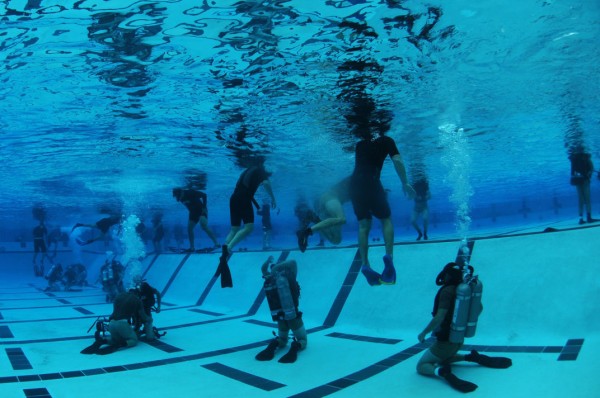
Half the way took from forty seconds to a minute, but it seemed to me that much more time had passed. The lungs already began to demand air and I wanted to surface as soon as possible. When I reached the first wall, I tumbled and headed back.
The lungs were burning. I felt like a stranglehold was tied around my neck. This was the first step towards failure. It seemed that I was about to vomit. The brain wanted to be given air. Panic almost gripped me, but I was able to curb my emotions and shove them deeper into me. I again tried to concentrate on the strokes, the wall was closer.
"Just keep sailing."
I was suffocating. The body rebelled. The lungs were on fire. I continued to swim. The mind was clouded, and the panic returned again.
It was a serious struggle with myself. I stayed underwater. If I can't do this in a clean and warm pool in sunny San Diego, then what should I do in the waters of the North Atlantic, and even in a storm?
The stranglehold on the neck was tightening, and the wall was getting closer. I started to lose consciousness. It was getting dark in my eyes and I realized there were seconds left before I was knocked out.
I was against the wall. Strong hands grabbed me, and the instructor pulled my body out of the water like a caught fish. I fell to the ground and began to inhale deeply. The lungs were slowly letting go. I caught my breath a little more and tried to get up.
"Lie down!" one of the instructors barked at me.
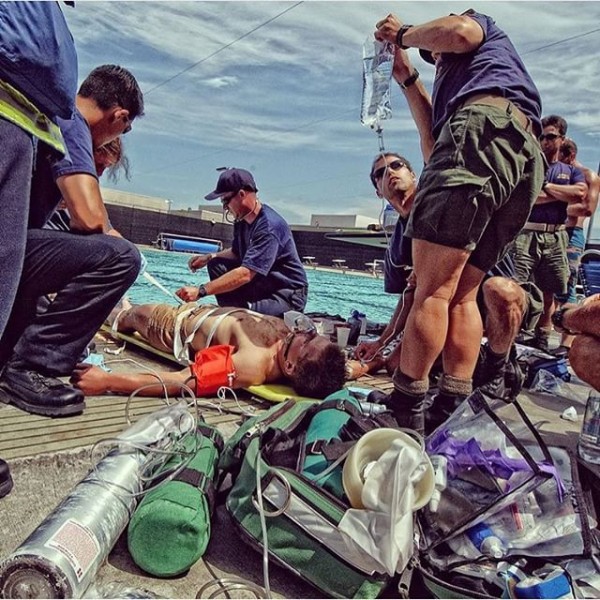
And my head sank back onto the warm tile. It is very rare when a BUD / S instructor gives you a rest and I especially did not resist my position. One by one, my companions completed this test. I saw how one of the guys, limp, was pulled out of the water and laid on the ground. He was passed out. Suddenly he took several deep and sharp breaths and regained consciousness. A minute later, he looked expectantly at the instructor.
"Did I do it?"
The guy didn't even realize that moments before he had been unconscious. I understood him perfectly and hoped that he did not fail the test. In this case, for us, failing the test was like death.
“Relax and lie still,” the instructor replied.
The sun warmed my back pleasantly. Paradise moments. The instructor immediately noticed that I was already in perfect order.
“Get your ass up and line up with the rest. You passed the test. " These words made me happy.
Everyone who comes to BUD / S does not initially think that they will fail somewhere. The qualifying course made me dig deeper. I never doubted myself, I knew that I would go this hard way. The mistake of many people is that they think that "SEALs" are such absolutely self-confident guys. But after a 50-meter swim under water, "Hell Week", diving training, where instructors are trying to drain you at all costs, we begin to realize the limits of our capabilities and understand how you can go beyond them. During BUD / S, I had to overcome many obstacles in order to understand that I can do everything that is required of me and even more.
But now, in Alaska, I had to clench all my feelings into a fist. I already began to doubt the success of our mission, but there was no turning back, especially since my guys were nearby, which added a little confidence.
After a couple of minutes, my face went numb. The current carried us towards the bay. The widest part of the Ketchikan Creek is about 20 feet, the depth is 5 feet, while we had to swim on the surface of the water under the bridge. We were wearing Drager diving equipment. It did not leave bubbles behind us when we exhaled, which greatly helped to maintain our disguise.
As I floated under the bridge, I heard cars driving across it. And somewhere ahead, on the piers, there were patrols. From the ship, beams of searchlights cut through the darkness in search of divers.
The bridge was left behind, the depth increased, and we began to sink. We found ourselves in pitch darkness. Trying to stay closer to the coastline, we were looking for a convenient approach to the desired pier.
Having sailed to one of the pillars, we decided on our further direction and continued our further movement in the dark. I put my hand forward - there were algae everywhere.
I imagined that at any moment a dolphin's nose could appear and push me to the surface. Moving along the maze of supports overgrown with algae, we tried to swim as slowly as possible. There was a lot of rubbish at the bottom. Several times I hooked some metal rubbish with my fins. Each time we approached a new support, we tried to be as careful as possible for fear of damaging the wetsuit with sharp metal edges. If icy water gets under the wetsuit, it will lead to unpredictable consequences. The prospect of drowning was real.
My partner was there, I could feel it by the tension on the rope on my diving belt. In the impenetrable darkness, I swam with one hand outstretched, right in front of my face. I saw absolutely nothing. Besides the darkness, we fought the cold. In addition to the cold, we were afraid of dolphins and besides dolphins, we thought how not to get lost among this forest of supports. Sounds like claustrophobia.
The green compass dial on my wrist was barely visible. We tried to stay in the right direction, but every few feet we had to bend around the supports. An hour later we were at our ship. I mentally exhaled when we were next to his body. An unusual sensation - here you are floating in pitch darkness, your arms are outstretched and suddenly you are buried in the hull of a huge battle ship. You feel like a grain of sand. Half the job was done. Now it remains to "mine" the ship and return unnoticed to our truck.
The ship was really big. I waited for my partner to take the telescopic pole attached to my back. This pole looked like a scaled-down copy of a gas station advertising pole. At the base of the pole were a removable magnet and small wheels. I took out a couple of training mines from my belt bag and attached them to it. Spinning the wheels and making sure that they turn freely, I touched my partner's shoulder. He took the pole, leaned the wheels against the hull of the ship and led it up to the right place. The explosive device was attached to the skin with a magnet. As soon as the end of the pole reached the waterline, we moved the magnet as close as possible to the ship's hull. I heard a characteristic sound - "knock", the device was fixed. Disconnecting the pole from the bombs with a magnet, I lowered it down. I was worried that the same "thud" could be heard on the ship.
I closed my eyes and tried to concentrate. Everything had to be done by touch. In the dark, my mind began to invent something that was not. Sometimes it seemed to me that I saw some movement in the water. And in those moments I was already expecting that now the killer dolphin would hit me in the side, from these thoughts my heart was breaking out.
The installation of a training explosive device was finished.
My partner reassembled the pole and secured it to my back, after which we began the long journey back to the waiting van. When we again passed under the bridge, snow fell. After two hours of work in cold water, I felt terribly tired. There was absolutely nothing left to the car, we had to climb up the river and we were there.
Once on the shore, my legs began to shake from the cold. Someone covered me with a blanket and helped me carry my gear to the car. My face was still numb and for a while I could not speak. A minute later, we again found ourselves in the darkness of the car salon, taking us back to the hotel. I didn't feel my face, but I think I was smiling then.
We were newbies - just with BUD / S and now we have completed the training mission. Yes, they were teachings, but they were not simple. There were training assignments before, but this time our senior officer entrusted us with planning and carrying out the mission on his own and we coped. I felt proud of this trust.
"Has anyone seen dolphins?" one of ours asked.
“Nope, I haven't seen anything,” I replied.
“Every time it seemed to me that there was some movement in the water, I was already ready that now all the shit would be knocked out of me,” said another.
As a result, it turned out that the dolphin, which was in free swimming, chased shoals of fish and did not care for us. Two dolphins in cages on the ship, which are usually used in warmer waters like San Diego Bay, rang a bell every 10 minutes, for which they received a fish. The constant noise of oxygen cylinders dropped by our comrades masked us from dolphin sonars, no one heard or saw how we mined the ship. In short, in fact, everything went like clockwork.
And I was nervous ... But I tried to concentrate on that task just like when I took the test in the pool during the BUD / S. My self-confidence has increased, not one hundred percent, but still. A few years later, I got into a real battle, but no longer paid attention to anything, be it pitch darkness, icy water or killer dolphins. As soon as the fight began, there was not a single thought that I could lose it. Looking back, I can say that my self-confidence grew with my experience in training or in real combat work. My parents taught me to be purposeful and once, having earned the trust, I set out on the path to the high rank of an experienced fighter and team member.
Of course, I still had a lot to learn.
Source: https://lost-unit.livejournal.com/204151.html
Author: Lost-unit










































































































































